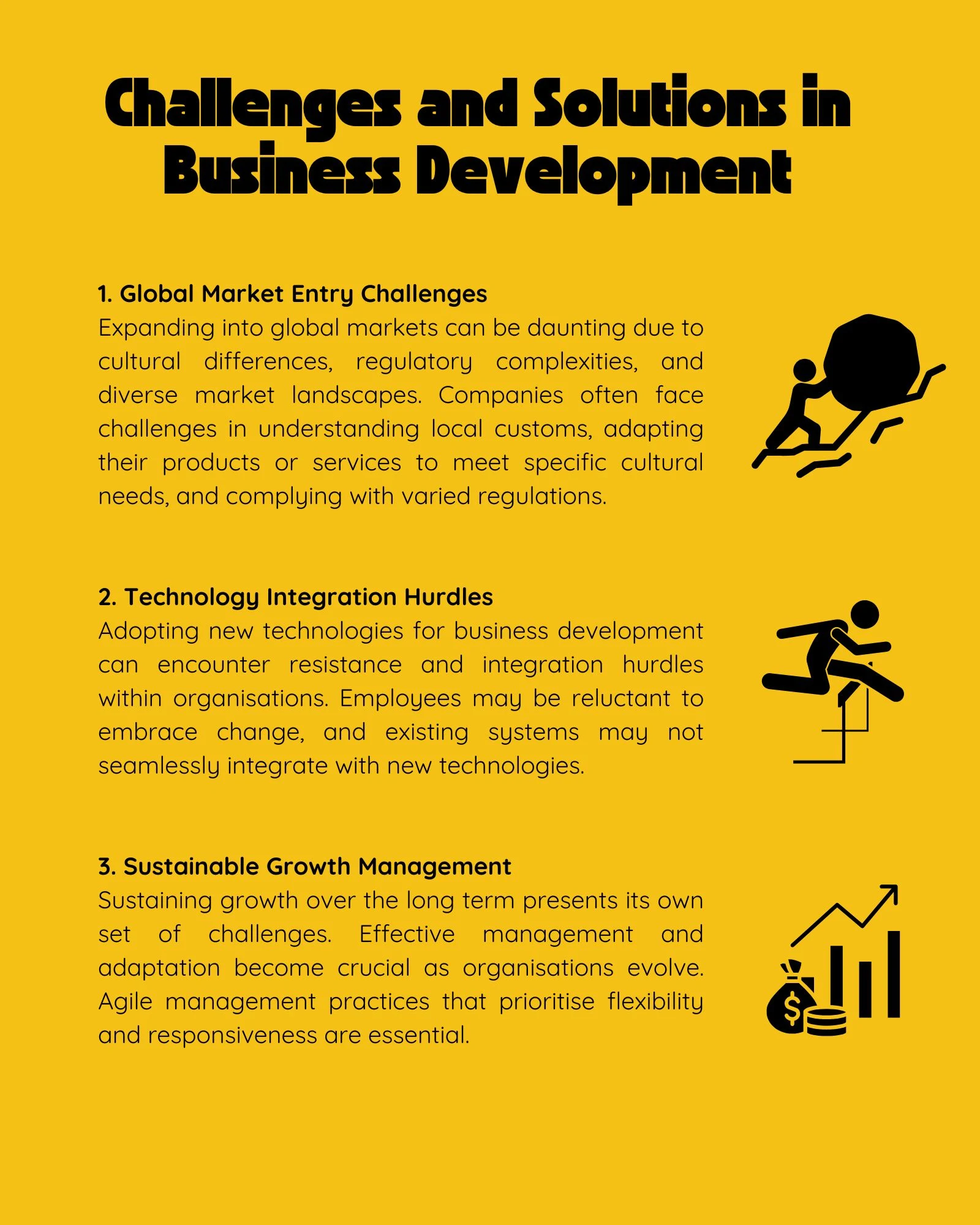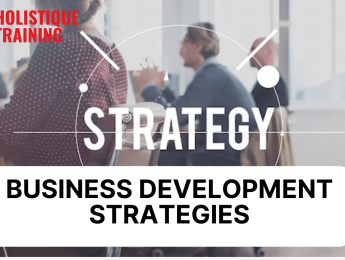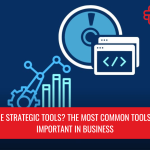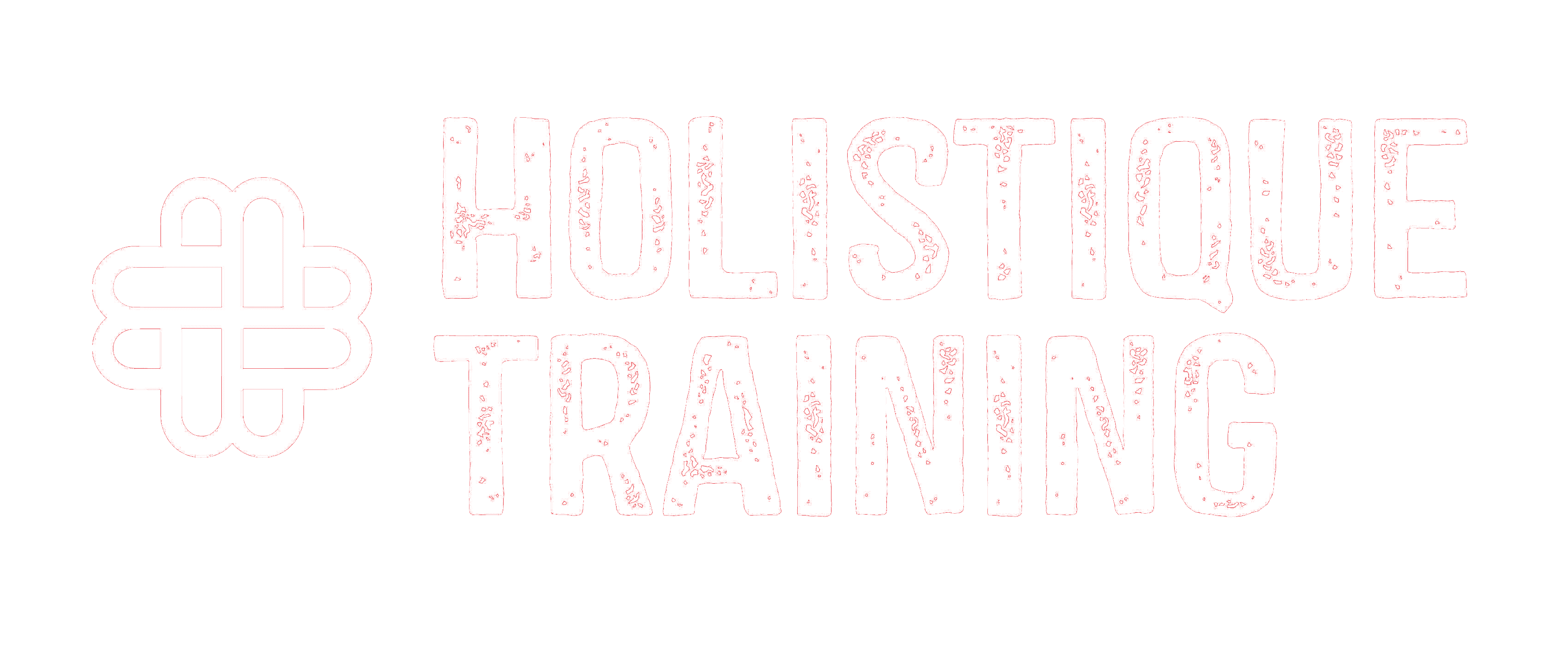- Table of Contents
- Introduction
- What Is Business Development?
- Why Is Implementing a Business Development Plan Important?
- Proactive Pursuit of Growth Opportunities
- Clear Objectives and Resource Allocation
- Enhanced Likelihood of Success
- Structured Framework for Evaluation
- Adaptation to Market Dynamics
- Innovation and Value Creation
- Competitive Edge
- How to Create Your Strategic Business Development Plan
- 1- Define your goals
- 2- Assess the current state
- 3- Identify target markets
- 4- Build strategic partnerships
- 5- Implement effective marketing and sales strategies
- 6- Foster innovation
- 7- Measure and adapt
- Top Business Development Strategies
- 1. Market Expansion
- 2. Strategic Alliances and Partnerships
- 3. Product or Service Diversification
- 4. Customer Relationship Management
- 5. Innovation and Technology Adoption
- 6. Mergers and Acquisitions
- 7. Strategic Networking and Thought Leadership
- Challenges and Solutions in Business Development
- 1. Global Market Entry Challenges
- 2. Technology Integration Hurdles
- 3. Sustainable Growth Management
- Innovations in Business Development
- 1. Artificial Intelligence in Business Development
- 2. Blockchain Technology for Partnerships
- 3. Virtual Reality in Customer Engagement
- Conclusion
Introduction
In the ever-evolving world of business, growth and success are not guaranteed. Organisations must actively pursue strategic opportunities, foster relationships, and innovate to thrive in a competitive landscape. This is where business development comes into play. This blog post will explore the importance of implementing a business development plan and provide actionable steps to create an effective strategy. Additionally, we will discuss some of the top business development strategies that can drive growth and propel your organisation towards sustainable success.
What Is Business Development?
Before delving into the strategies, let's first define business development. Business development encompasses various activities to identify and create growth opportunities for an organisation. It involves establishing and nurturing relationships with potential partners, customers, and stakeholders while also seeking new markets and channels for expansion. Business development is not limited to sales and marketing; it encompasses a broader approach focusing on long-term growth and value creation.
Why Is Implementing a Business Development Plan Important?
Business development plays a pivotal role in the success and sustainability of any organisation. Its significance lies in its ability to proactively shape an organisation's trajectory rather than merely reacting to market changes. Here's a deeper exploration of why implementing a business development plan is crucial:
Proactive Pursuit of Growth Opportunities
Business development allows organisations to take a proactive stance in identifying and seizing growth opportunities. According to an article published by Excellent Business Plans, implementing a well-developed business plan increases the likelihood of achieving growth by an impressive 30%. Rather than being passive observers of market shifts, businesses with well-defined plans can actively shape their future, ensuring they stay ahead of the curve.
Clear Objectives and Resource Allocation
Organisations can set clear and measurable objectives by developing a robust business development plan. This clarity in goals facilitates effective resource allocation, ensuring that time, finances, and manpower are directed toward endeavours that align with the overall growth strategy.
Enhanced Likelihood of Success
According to an article published by Excellent Business Plans, implementing a well-developed business plan increases the likelihood of achieving growth by an impressive 30%. This statistic underscores the tangible impact that a thoughtful and strategic approach to business development can have on an organisation's success.
Structured Framework for Evaluation
A business development plan provides a structured framework for evaluating potential partnerships, exploring new markets, and optimising existing operations. This systematic approach enables organisations to make informed decisions based on a thorough understanding of their strengths, weaknesses, opportunities, and threats.
Adaptation to Market Dynamics
Markets are dynamic and subject to constant change. A comprehensive business development plan empowers organisations to adapt swiftly to these changes. Whether it's shifts in consumer behaviour, emerging technologies, or new competitors entering the scene, a well-crafted plan ensures that the organisation is agile and responsive.
Innovation and Value Creation
Business development extends beyond immediate revenue generation. It fosters a culture of innovation within the organisation. By actively seeking new markets and opportunities, businesses are encouraged to innovate in their products, services, and processes, creating value that resonates with their target audience.
Competitive Edge
A solid business development strategy provides a competitive edge in a crowded marketplace. Understanding customer needs, identifying unique selling propositions, and developing tailored strategies position an organisation as a leader rather than a follower in its industry.
The importance of business development cannot be overstated. It acts as a guiding compass for organisations, navigating them through the complex landscape of modern business and positioning them for sustainable growth and long-term success.
How to Create Your Strategic Business Development Plan
Creating a strategic business development plan requires a systematic approach and careful consideration of various factors. Here are the key steps to develop an effective plan:
1- Define your goals
The foundation of any effective business development plan lies in clearly defining your goals. These goals should align seamlessly with your organisation's overall strategic objectives. Consider both short-term and long-term goals to ensure a balanced approach. Articulated goals serve as guiding beacons, providing a sense of direction for your business development initiatives.
2- Assess the current state
Before charting a path forward, assess your organisation's strengths, weaknesses, opportunities, and threats (SWOT analysis). Evaluate your existing market position, core competencies, and available resources. This analysis will provide a realistic understanding of your starting point, identifying areas for improvement and pinpointing potential growth opportunities.
3- Identify target markets
Research and identify target markets that align with your business objectives. Consider factors such as market size, growth potential, competitive landscape, and customer demographics. Narrow down your focus to a few key markets that offer the most promising opportunities for expansion. A targeted approach ensures that resources are allocated efficiently for maximum impact.
4- Build strategic partnerships
Strategic partnerships play a pivotal role in accelerating business growth. Identify potential partners who can complement your strengths and help you reach your target markets more effectively. Building relationships based on trust, mutual benefit, and shared goals is essential for fostering long-term collaborations. The right partnerships can enhance capabilities, extend market reach, and create a synergy that propels mutual success.
5- Implement effective marketing and sales strategies
A robust marketing and sales strategy is a cornerstone of successful business development. Align your strategy with your target markets, leveraging digital marketing tools, social media platforms, and content marketing to raise brand awareness. Implement effective sales tactics to convert leads into loyal customers. Consistency and adaptability in your marketing and sales efforts are crucial for connecting with your audience and driving conversion.
6- Foster innovation
Embrace a culture of innovation within your organisation. Encourage employees to think creatively, experiment with new ideas, and continuously improve products or services. Innovation is a powerful driver of differentiation in the market, helping your organisation stand out from competitors. It also ensures that your offerings remain relevant and compelling to your target audience.
7- Measure and adapt
A successful business development plan is not static; it requires ongoing measurement and adaptation. Regularly track the progress of your initiatives using key performance indicators (KPIs). Analyse the data collected and use it to refine your approaches. Adapt your plan based on the evolving business landscape, seizing emerging opportunities and addressing challenges promptly. A culture of continuous improvement ensures that your business development strategies remain dynamic and effective.
In short, creating a strategic business development plan demands a thoughtful and comprehensive approach. By systematically defining goals, assessing the current state, identifying target markets, building partnerships, implementing effective marketing and sales strategies, fostering innovation, and maintaining adaptability through measurement, organisations can lay the groundwork for sustained growth and success.
Top Business Development Strategies
Now let's explore some of the top business development strategies that have proven to be effective in driving growth:
1. Market Expansion
Identifying and tapping into new geographic markets or customer segments with untapped potential is a fundamental strategy for business development. By strategically expanding operations, organisations can reach a broader audience and tailor their offerings to meet the specific needs of diverse markets. This approach fosters growth and provides a hedge against market saturation.
2. Strategic Alliances and Partnerships
Collaborating with complementary businesses through strategic alliances is a powerful approach. These partnerships can leverage combined expertise, resources, and customer bases. Joint ventures, licensing agreements, and distribution partnerships are examples of how organisations can forge alliances that open new avenues for growth. Building relationships based on trust and shared goals is key to establishing long-term, mutually beneficial collaborations.
3. Product or Service Diversification
Developing new products or services that either cater to existing customer needs or target entirely new markets is a proactive business development strategy. Diversification allows organisations to spread risks, capture new revenue streams, and stay competitive in a rapidly evolving business landscape. It also positions them as innovative leaders in their industry.
4. Customer Relationship Management
Cultivating strong relationships with existing customers is a strategy often overlooked but crucial for sustainable growth. Personalised experiences, exceptional customer service, and loyalty programmes are avenues through which businesses can ensure customer satisfaction. Satisfied customers become brand advocates, contributing to long-term growth through referrals and positive word-of-mouth.
Strategy | Key Advantages | Considerations |
Market Expansion | Access to new customer bases, potential revenue growth | Requires extensive market research and adaptation strategies |
Strategic Alliances | Leverage partner resources, shared risks and rewards | Building and maintaining trust is critical for successful alliances |
Product or Service Diversification | Spread risks, tap into new revenue streams | Requires in-depth market analysis and a robust R&D capability |
Customer Relationship Management | Cultivates loyalty, drives word-of-mouth referrals | Demands consistent and exceptional customer service practices |
Innovation and Technology Adoption | Competitive edge aligns with market trends | Ongoing investment in R&D, potential resistance to technological changes |
Table 1: Comparative analysis of business development strategies
5. Innovation and Technology Adoption
Embracing emerging technologies and innovative approaches is paramount for staying competitive. Innovation sets businesses apart from their competitors, whether it involves enhancing products, services, or internal processes. Staying updated with industry trends and investing in research and development are integral to a successful business development strategy.
6. Mergers and Acquisitions
Exploring opportunities for mergers or acquisitions aligns with growth objectives. Acquiring or merging with a complementary business can provide instant access to new markets, technologies, or capabilities. It is a strategic move that, if executed effectively, can significantly enhance an organisation's market position and accelerate growth.
7. Strategic Networking and Thought Leadership
Building a strong network of industry professionals, influencers, and thought leaders is a proactive strategy for business development. Actively participating in conferences and industry events and sharing expertise through thought leadership content establishes credibility and attracts new business opportunities. Networking is a platform for collaboration, learning, and staying abreast of industry trends.
In fact, statistics show that when venturing into uncharted territories where a brand lacks recognition, 60% of buyers affirm that thought leadership plays a pivotal role in establishing credibility. Furthermore, 57% of buyers acknowledge the ability of thought leadership to cultivate awareness for a brand that is either new or relatively unknown in the market.
Incorporating these diverse strategies into your business development plan provides a comprehensive approach to achieving sustainable growth. Each strategy contributes uniquely to the overarching goal, ensuring that organisations are well-equipped to navigate the complexities of the business landscape and emerge as leaders in their respective industries.
Challenges and Solutions in Business Development
While business development is instrumental in achieving growth and success, it has challenges. Recognising and addressing these challenges is essential for organisations to navigate the complexities of the business landscape effectively.

1. Global Market Entry Challenges
Expanding into global markets can be daunting due to cultural differences, regulatory complexities, and diverse market landscapes. Companies often face challenges in understanding local customs, adapting their products or services to meet specific cultural needs, and complying with varied regulations. The solution lies in conducting thorough market research to gain insights into the target market, formulating localisation strategies to align with cultural nuances, and establishing local partnerships to navigate regulatory landscapes more effectively.
2. Technology Integration Hurdles
Adopting new technologies for business development can encounter resistance and integration hurdles within organisations. Employees may be reluctant to embrace change, and existing systems may not seamlessly integrate with new technologies. To overcome this, organisations should implement comprehensive training programs to familiarise employees with the benefits of technology adoption. Emphasising the positive impact on efficiency and productivity and involving employees in the transition process can lead to a smoother technology integration.
3. Sustainable Growth Management
Sustaining growth over the long term presents its own set of challenges. Effective management and adaptation become crucial as organisations evolve. Agile management practices that prioritise flexibility and responsiveness are essential. Continual reassessment and adjustment of strategies based on changing market dynamics, customer needs, and technological advancements are necessary for sustained success. Fostering a culture of continuous improvement, where feedback is valued, and lessons learned are applied, is key to managing the complexities of sustainable growth.
Addressing these challenges requires a holistic and strategic approach. Organisations must be proactive in identifying potential roadblocks and agile and adaptable in implementing solutions. By doing so, they can position themselves to overcome challenges, capitalise on opportunities, and achieve sustained growth in an ever-evolving business landscape.
Innovations in Business Development
In a world driven by technological advancements and rapid changes, innovations in business development are essential for staying competitive and relevant. Here, we explore three fascinating innovations reshaping the business development landscape.
1. Artificial Intelligence in Business Development
Artificial intelligence (AI) integration has revolutionised how organisations identify and pursue opportunities. AI algorithms analyse vast amounts of data, providing valuable insights into market trends, customer behaviours, and potential partnership opportunities. This innovation streamlines decision-making, allowing businesses to make informed choices based on data-driven intelligence. From predictive analytics to personalised customer interactions, AI is becoming a cornerstone for effective business development strategies.
2. Blockchain Technology for Partnerships
Blockchain technology, known for its role in secure and transparent transactions, is making waves in business development partnerships. Smart contracts on blockchain facilitate transparent and secure agreements between business partners. This innovation reduces the risk of disputes, enhances trust, and expedites negotiation. By providing a decentralised and tamper-proof platform, blockchain transforms how partnerships are established and maintained, fostering stronger and more efficient collaborations.
Application | Description | Impact |
Predictive Analytics | Anticipates market trends for informed decisions | Enhances strategic planning |
Customer Insights | Analyses data to understand and predict behaviour | Improves targeted marketing strategies |
Lead Scoring | Automates evaluation for prioritised sales focus | Optimises resource allocation |
Relationship Mapping | Identifies key connections for strategic alliances | Facilitates targeted partnership building |
Table 2: Applications of AI in business development
3. Virtual Reality in Customer Engagement
Virtual Reality (VR) is emerging as a powerful tool in customer engagement, a critical aspect of business development. VR experiences enable businesses to create immersive presentations, virtual product demos, and interactive simulations. This innovation goes beyond traditional modes of communication, allowing for more compelling and memorable interactions with potential partners and customers. By providing a virtual environment where stakeholders can experience products or services firsthand, businesses can create a lasting impact and set themselves apart in a competitive market.
These innovations showcase the transformative power of technology and highlight the dynamic nature of business development. Embracing these technological advancements allows organisations to enhance their strategies, reach new heights of efficiency, and create more meaningful connections with partners and customers. As the business landscape evolves, staying abreast of such innovations becomes crucial for organisations seeking to thrive in the ever-changing marketplace.
Conclusion
Effective business development strategies are essential for organisations seeking sustainable growth and success. By creating a strategic plan, fostering innovation, building partnerships, and leveraging emerging opportunities, businesses can unlock their full potential and stay ahead of the competition. Remember, business development is an ongoing process that requires adaptability, resilience, and a relentless pursuit of excellence. Embrace the strategies mentioned in this blog post, tailor them to your organisation's unique needs, and embark on a transformative journey towards business growth and prosperity.
In your transformative journey towards business growth and prosperity, equip yourself with the skills and insights needed to master the art of business development. Elevate your strategic acumen with our ‘In-Depth Business Management Professional Training’, a comprehensive course designed to empower you to implement these strategies effectively. Seize the opportunity to not just stay ahead but to lead in the ever-evolving world of business. Enroll now and unlock a pathway to unparalleled success!






















